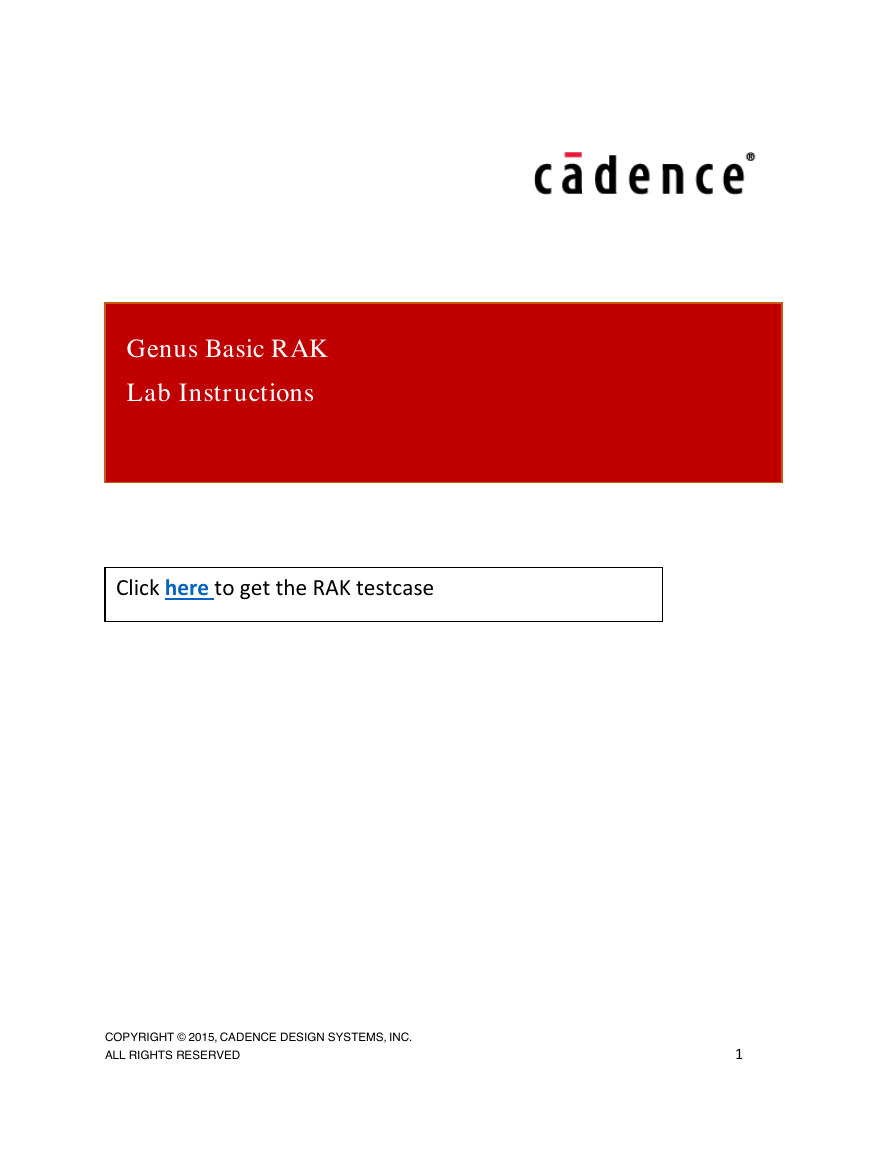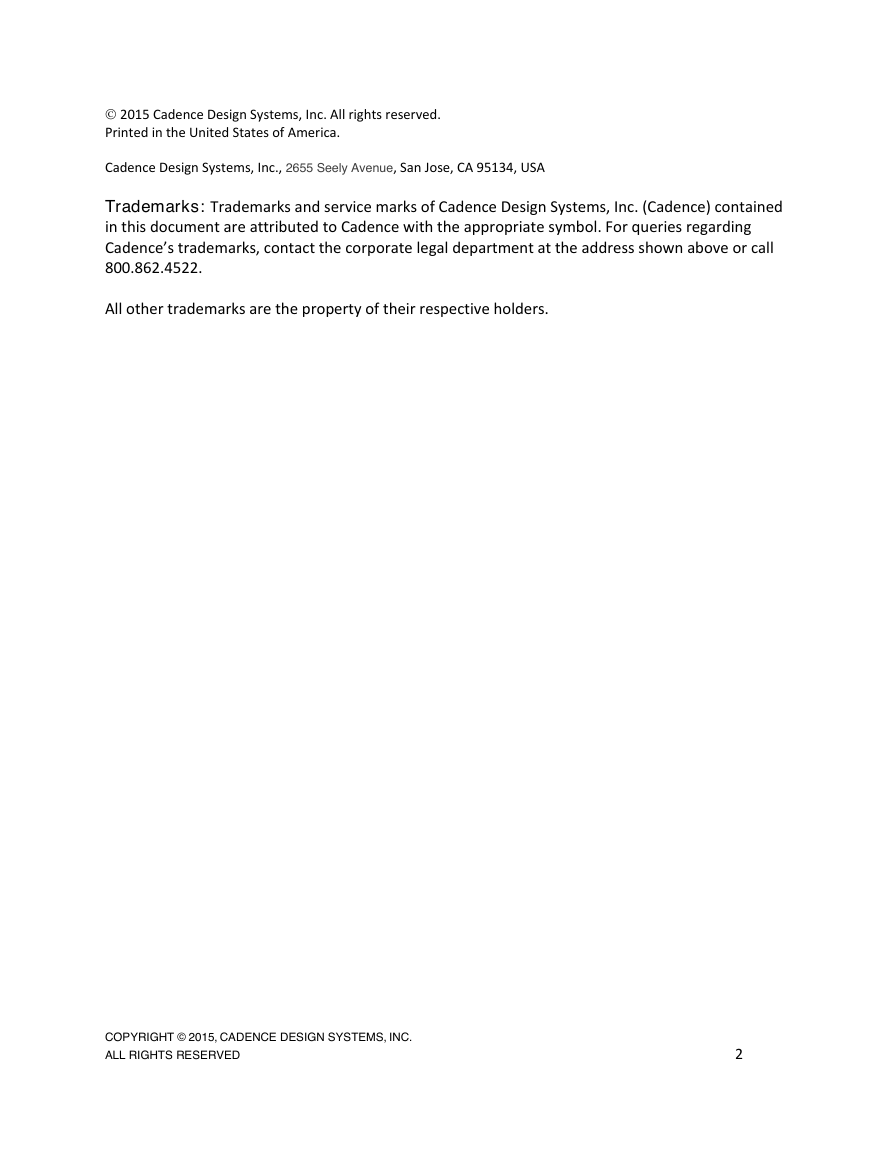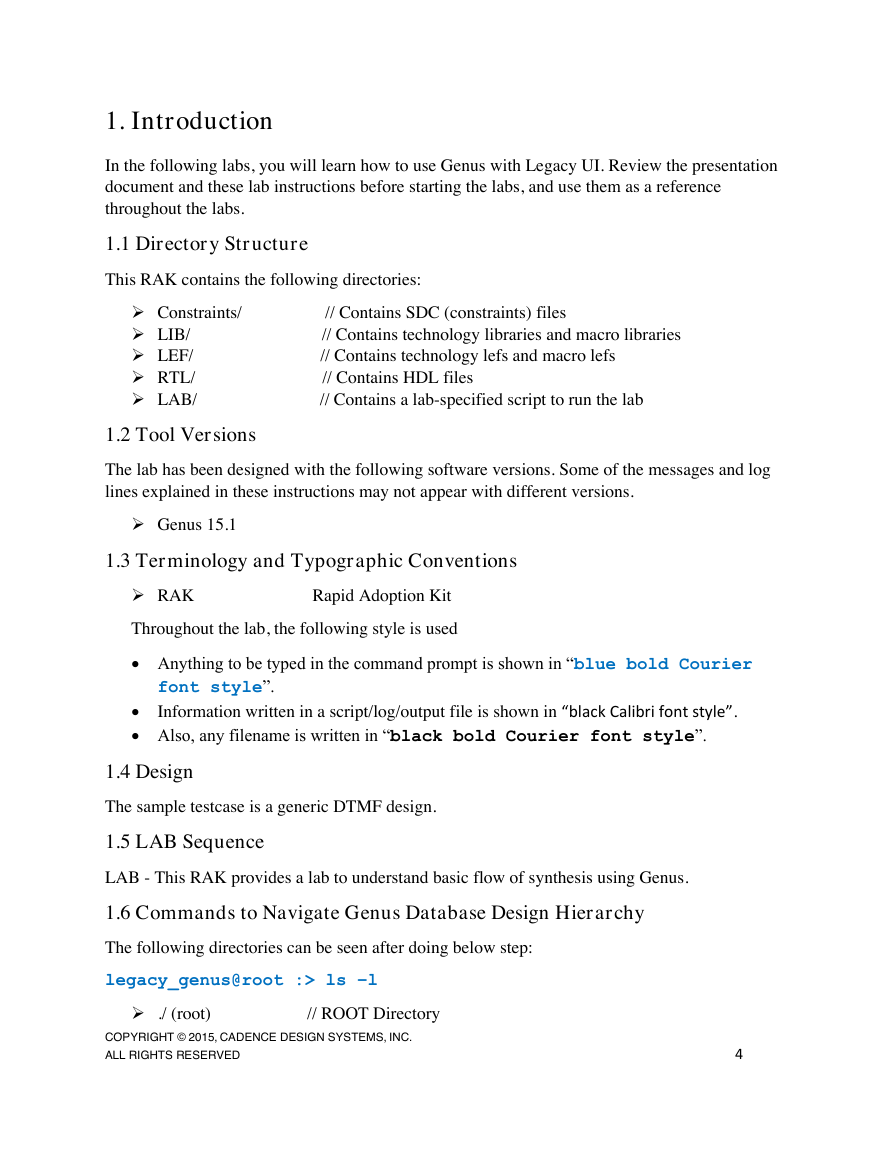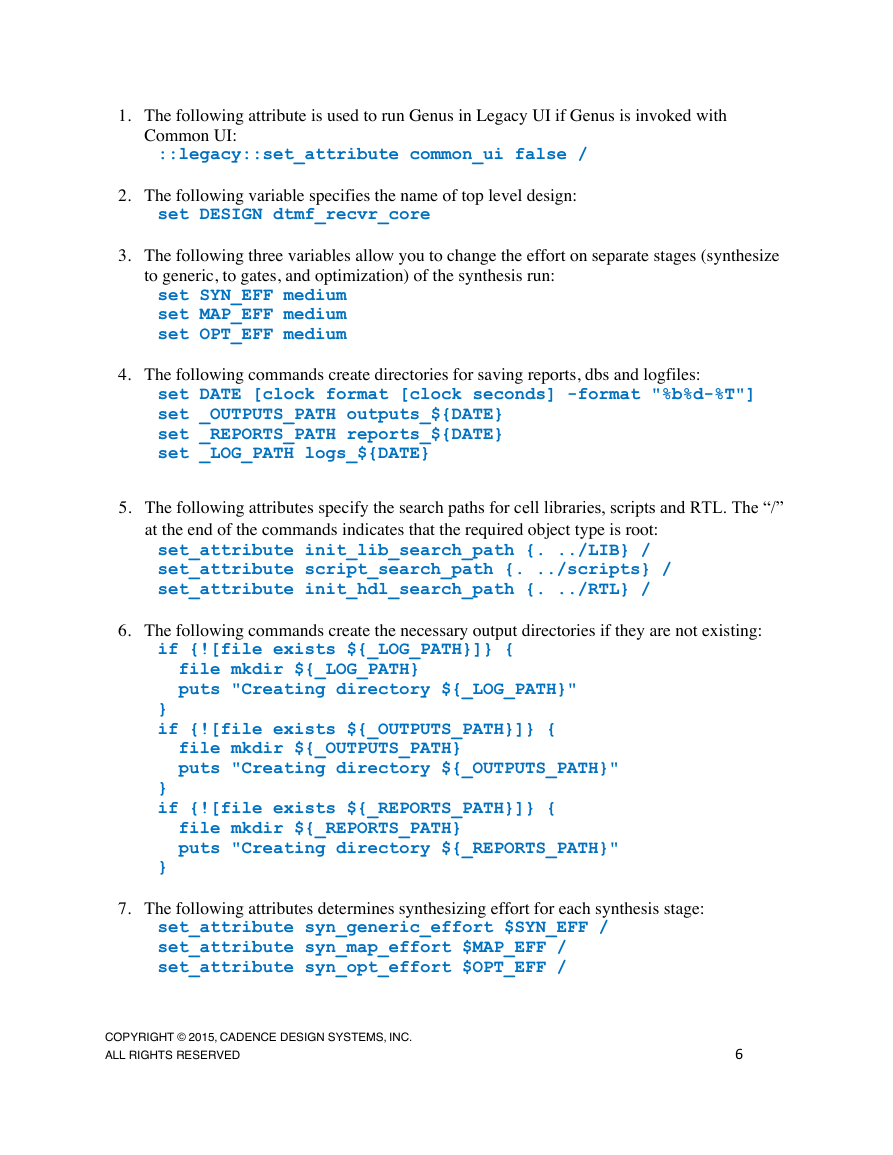Genus Basic RAK
Lab Instructions
Click here to get the RAK testcase
COPYRIGHT © 2015, CADENCE DESIGN SYSTEMS, INC.
ALL RIGHTS RESERVED
1
�
2015 Cadence Design Systems, Inc. All rights reserved.
Printed in the United States of America.
Cadence Design Systems, Inc., 2655 Seely Avenue, San Jose, CA 95134, USA
Trademarks: Trademarks and service marks of Cadence Design Systems, Inc. (Cadence) contained
in this document are attributed to Cadence with the appropriate symbol. For queries regarding
Cadence’s trademarks, contact the corporate legal department at the address shown above or call
800.862.4522.
All other trademarks are the property of their respective holders.
COPYRIGHT © 2015, CADENCE DESIGN SYSTEMS, INC.
ALL RIGHTS RESERVED
2
�
Contents
1. Introduction ................................................................................................................................. 4
1.1 Directory Structure ................................................................................................................ 4
1.2 Tool Versions ........................................................................................................................ 4
1.3 Terminology and Typographic Conventions ......................................................................... 4
1.4 Design.................................................................................................................................... 4
1.5 LAB Sequence ....................................................................................................................... 4
1.6 Commands to Navigate Genus Database Design Hierarchy ................................................. 4
2. LAB: Base Lab for Genus........................................................................................................... 5
2.1 Objective ............................................................................................................................... 5
2.2 Lab Files ................................................................................................................................ 5
2.3 Running the Lab .................................................................................................................... 5
2.4 Understanding the Flow ........................................................................................................ 5
COPYRIGHT © 2015, CADENCE DESIGN SYSTEMS, INC.
ALL RIGHTS RESERVED
3
�
1. Introduction
In the following labs, you will learn how to use Genus with Legacy UI. Review the presentation
document and these lab instructions before starting the labs, and use them as a reference
throughout the labs.
1.1 Directory Structure
This RAK contains the following directories:
Constraints/ // Contains SDC (constraints) files
LIB/ // Contains technology libraries and macro libraries
LEF/ // Contains technology lefs and macro lefs
RTL/ // Contains HDL files
LAB/ // Contains a lab-specified script to run the lab
1.2 Tool Versions
The lab has been designed with the following software versions. Some of the messages and log
lines explained in these instructions may not appear with different versions.
Genus 15.1
1.3 Terminology and Typographic Conventions
RAK Rapid Adoption Kit
Throughout the lab, the following style is used
Anything to be typed in the command prompt is shown in “blue bold Courier
font style”.
Information written in a script/log/output file is shown in “black Calibri font style”.
Also, any filename is written in “black bold Courier font style”.
1.4 Design
The sample testcase is a generic DTMF design.
1.5 LAB Sequence
LAB - This RAK provides a lab to understand basic flow of synthesis using Genus.
1.6 Commands to Navigate Genus Database Design Hierarchy
The following directories can be seen after doing below step:
legacy_genus@root :> ls –l
./ (root) // ROOT Directory
COPYRIGHT © 2015, CADENCE DESIGN SYSTEMS, INC.
ALL RIGHTS RESERVED
4
�
designs/ // Contains the designs for each module loaded into Genus
hdl_libraries/ // Contains the VHDL architecture libraries
libraries/ // Contain the technology libraries that have been read in
messages/ // List of messages that are displayed during the Genus session
object_types/ //Contains list of Objects associated with the Design
go into various directories above
legacy_genus@root :> cd
Make sure to get back to the root directory in Genus by entering:
legacy_genus@root :> cd
2. LAB: Base Lab for Genus
2.1 Objective
Use Genus to execute a simple compile of the DTMF design
Go to LAB Directory
2.2 Lab Files
This lab uses following files:
run.tcl: This script is created by generating a simple template from Genus in Legacy
UI and then modified accordingly. The following commands are used to invoke Genus in
Legacy UI and create a template file :
unix:> genus –legacy_ui
legacy_genus@root :> write_template –outfile run.tcl
If ‘-legacy_ui’ is not specified when Genus is invoked, Genus will be invoked with
Common UI.
genus.log: Log file for this lab
2.3 Running the Lab
You may run commands within ‘run.tcl’ script line by line in Genus session, or you may run
all the commands at once using scripts with either one of following ways:
legacy_genus@root :> source run.tcl
unix:> genus –legacy_ui –f run.tcl –log genus.log
2.4 Understanding the Flow
Open the run.tcl file and review the following commands in that file.
COPYRIGHT © 2015, CADENCE DESIGN SYSTEMS, INC.
ALL RIGHTS RESERVED
5
�1. The following attribute is used to run Genus in Legacy UI if Genus is invoked with
Common UI:
::legacy::set_attribute common_ui false /
2. The following variable specifies the name of top level design:
set DESIGN dtmf_recvr_core
3. The following three variables allow you to change the effort on separate stages (synthesize
to generic, to gates, and optimization) of the synthesis run:
set SYN_EFF medium
set MAP_EFF medium
set OPT_EFF medium
4. The following commands create directories for saving reports, dbs and logfiles:
set DATE [clock format [clock seconds] -format "%b%d-%T"]
set _OUTPUTS_PATH outputs_${DATE}
set _REPORTS_PATH reports_${DATE}
set _LOG_PATH logs_${DATE}
5. The following attributes specify the search paths for cell libraries, scripts and RTL. The “/”
at the end of the commands indicates that the required object type is root:
set_attribute init_lib_search_path {. ../LIB} /
set_attribute script_search_path {. ../scripts} /
set_attribute init_hdl_search_path {. ../RTL} /
6. The following commands create the necessary output directories if they are not existing:
if {![file exists ${_LOG_PATH}]} {
file mkdir ${_LOG_PATH}
puts "Creating directory ${_LOG_PATH}"
}
if {![file exists ${_OUTPUTS_PATH}]} {
file mkdir ${_OUTPUTS_PATH}
puts "Creating directory ${_OUTPUTS_PATH}"
}
if {![file exists ${_REPORTS_PATH}]} {
file mkdir ${_REPORTS_PATH}
puts "Creating directory ${_REPORTS_PATH}"
}
7. The following attributes determines synthesizing effort for each synthesis stage:
set_attribute syn_generic_effort $SYN_EFF /
set_attribute syn_map_effort $MAP_EFF /
set_attribute syn_opt_effort $OPT_EFF /
COPYRIGHT © 2015, CADENCE DESIGN SYSTEMS, INC.
ALL RIGHTS RESERVED
6
�
8. The following attribute determines how much information will be written to the log file.
For debugging purposes and when providing a testcase to Cadence, set the value to 9. A
good value otherwise is 7 or 5 if you want to limit the details.
set_attribute information_level 9 /
9. The following attributes specify the various libraries and lefs to be used for the design:
set_attribute library
{ ../LIB/slow.lib ../LIB/pll.lib ../LIB/CDK_S128x16.lib .
./LIB/CDK_S256x16.lib
../LIB/CDK_R512x16.lib} /
set_attribute lef_library
{ ../LEF/gsclib045_tech.lef ../LEF/gsclib045_macro.lef ../L
EF/pll.lef
../LEF/CDK_S128x16.lef ../LEF/CDK_S256x16.lef ../LEF/CDK
_R512x16.lef } /
You can also specify cap tables files by using:
set_attribute cap_table_file /
10. The following commands load the RTL design into Genus memory, elaborate the top-level
module/entity $DESIGN, report the runtime and memory used up to this stage, and
prioritize the checking of unresolved instances (to ensure accuracy of the synthesis results):
read_hdl " pllclk.v accum_stat.v alu_32.v arb.v
data_bus_mach.v data_sample_mux.v
decode_i.v decoder.v \
digit_reg.v conv_subreg.v dma.v dtmf_recvr_core.v
execute_i.v m16x16.v mult_32_dp.v \
port_bus_mach.v prog_bus_mach.v ram_128x16_test.v
ram_256x16_test.v results_conv.v spi.v \
tdsp_core_glue.v tdsp_core_mach.v tdsp_core.v
tdsp_data_mux.v tdsp_ds_cs.v test_control.v \
ulaw_lin_conv.v power_manager.v "
elaborate $DESIGN
time_info Elaboration
check_design -unresolved
You can see the below messages in the log file after the execution of the above commands:
COPYRIGHT © 2015, CADENCE DESIGN SYSTEMS, INC.
ALL RIGHTS RESERVED
7
�
Info : Done Elaborating Design. [ELAB-3]
: Done elaborating 'dtmf_recvr_core'.
Computing net loads.
Runtime & Memory after 'read_hdl'
stamp 'Elaboration' being created for table 'default'
Total Time (Wall) | Stage Time (Wall) | % (Wall) | Date - Time | Memory | Stage
---------------------------+---------------------------+------------------+----------------------------+---------------+----------------------
00:00:05(00:00:00) | 00:00:00(00:00:00) | 0.0( 0.0) | 12:31:31 PM(Jul13) | 241.75 MB | init
---------------------------+---------------------------+-------------------+---------------------------+---------------+----------------------
00:00:11(00:00:06) | 00:00:06(00:00:06) | 100.0(100.0) | 12:31:37 PM(Jul13) | 345.02 MB | Elaboration
---------------------------+---------------------------+------------------+----------------------------+---------------+----------------------
Number of super-thread servers: 0 (id: default, time_info v1.52)
Info: (*N*) indicates data that was populated from previously saved time_info database
Checking the design.
Unresolved References & Empty Modules
-------------------------------------
No unresolved references in design 'dtmf_recvr_core'
No empty modules in design 'dtmf_recvr_core'
Done Checking the design.
Check Design Report
--------------------
11. The following command reads the sdc file, the log file shows following messages:
read_sdc ../Constraints/dtmf_recvr_core_gate.sdc
Reading file
Statistics for commands executed by read_sdc:
"create_clock"
"current_design"
"get_clocks"
"get_pins"
"get_ports"
"set_case_analysis"
"set_false_path"
"set_input_delay"
"set_max_fanout"
"set_max_transition"
"set_output_delay"
Total runtime0
- successful
- successful
- successful
- successful
- successful
- successful
- successful
- successful
- successful
- successful
- successful
7 , failed
3 , failed
364 , failed
7 , failed
369 , failed
2 , failed
2 , failed
175 , failed
1 , failed
1 , failed
189 , failed
0 (runtime 0.00)
0 (runtime 0.00)
0 (runtime 0.00)
0 (runtime 0.00)
0 (runtime 0.00)
0 (runtime 0.00)
0 (runtime 0.00)
0 (runtime 0.00)
0 (runtime 0.00)
0 (runtime 0.00)
0 (runtime 0.00)
12. The following command generates a lint report which reports, in an abbreviated output,
possible timing problems in the design:
report timing -lint
COPYRIGHT © 2015, CADENCE DESIGN SYSTEMS, INC.
ALL RIGHTS RESERVED
8
�
















 2023年江西萍乡中考道德与法治真题及答案.doc
2023年江西萍乡中考道德与法治真题及答案.doc 2012年重庆南川中考生物真题及答案.doc
2012年重庆南川中考生物真题及答案.doc 2013年江西师范大学地理学综合及文艺理论基础考研真题.doc
2013年江西师范大学地理学综合及文艺理论基础考研真题.doc 2020年四川甘孜小升初语文真题及答案I卷.doc
2020年四川甘孜小升初语文真题及答案I卷.doc 2020年注册岩土工程师专业基础考试真题及答案.doc
2020年注册岩土工程师专业基础考试真题及答案.doc 2023-2024学年福建省厦门市九年级上学期数学月考试题及答案.doc
2023-2024学年福建省厦门市九年级上学期数学月考试题及答案.doc 2021-2022学年辽宁省沈阳市大东区九年级上学期语文期末试题及答案.doc
2021-2022学年辽宁省沈阳市大东区九年级上学期语文期末试题及答案.doc 2022-2023学年北京东城区初三第一学期物理期末试卷及答案.doc
2022-2023学年北京东城区初三第一学期物理期末试卷及答案.doc 2018上半年江西教师资格初中地理学科知识与教学能力真题及答案.doc
2018上半年江西教师资格初中地理学科知识与教学能力真题及答案.doc 2012年河北国家公务员申论考试真题及答案-省级.doc
2012年河北国家公务员申论考试真题及答案-省级.doc 2020-2021学年江苏省扬州市江都区邵樊片九年级上学期数学第一次质量检测试题及答案.doc
2020-2021学年江苏省扬州市江都区邵樊片九年级上学期数学第一次质量检测试题及答案.doc 2022下半年黑龙江教师资格证中学综合素质真题及答案.doc
2022下半年黑龙江教师资格证中学综合素质真题及答案.doc